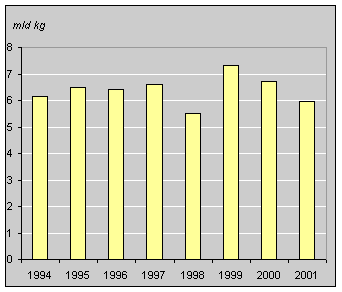Beet crop down

In 2001 the sugar beet crop in the Netherlands was twelve percent smaller than in 2000, at 5.9 billion kg. In the last eight years the annual crop of sugar beet has been an average 6.4 billion kg. This is the equivalent of ten million cubic metres, enough to fill a large football stadium ten times over.
Sugar beet crop

Fewer beet growers
A small part of the area sown with sugar beet was not harvested in 2001, and the yield of the area that was lifted was lower. The main reason for this is that it had been sown late in the season. Arable farmers lifted just over 55 thousand kg of sugar beet per hectare in 2001, compared with record yields of more than 61 thousand kg of sugar beet per hectare in 1999 and 2000.
The cultivation of sugar beet is an important branch of arable farming in the Netherlands. More than 16 thousand farmers grow this crop, one sixth fewer than five years ago. Half of farms growing these root crops are located in the three southern provinces: Zeeland, North Brabant and Limburg. However, the area devoted to this crop in these provinces accounts for no more than 37 percent of the total cultivated area of some 110 thousand hectares.
Fodder beet slowly disappearing
Fodder beet is slowly disappearing from Dutch fields. While two thousand hectares were still devoted to this crop in 1994, only one third of this area was left in 2001. The yields were also down last year. The fodder beet crop in 2001 was the lowest in the last eight years, and with 61 thousand kg per hectare the yield was more than a quarter down on 2000. Total production of fodder beet was only a quarter of the amount produced in 1994.
Folkert van der Werf